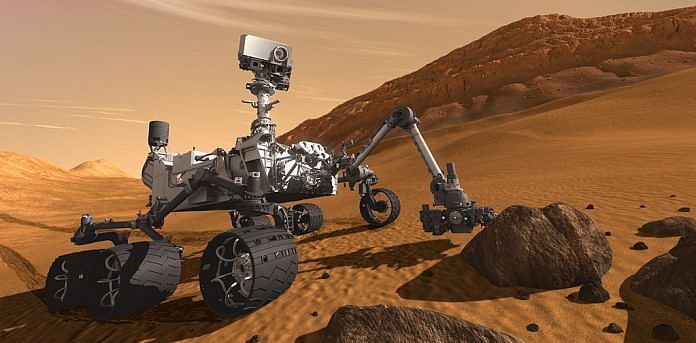Though not a confirmation of alien life, the results from Nasa do take us a step closer to deducing that Mars is a tad more hospitable to life than previously thought.
Bengaluru: Nasa scientists last week announced that the Curiosity rover has found evidence of mysterious methane in the Martian atmosphere as well as a 3-billion-year old organic material that could have facilitated life at some point.
Nasa said this methane was seasonal, peaking in concentration at the end of summers. The results published in the journal Science, while in no form confirmation of alien life, do take us one step closer to deducing that the planet is a tad more hospitable to life than previously thought.
The methane fixation
A prime biosignature for life, Methane, has finally been spotted with regularity on Mars after a long time.
On Earth, methane is the by-product of biological processes, including cow burps and farts. In fact, methane is one of the biggest greenhouse gases as well, thanks to the vast number of cattle we have. Methane tends to break down and disappear in the atmosphere because it isn’t stable enough to exist for long periods of time when exposed to the sun’s UV rays. In the Martian atmosphere, it breaks down in 300 years.
So when methane is found anywhere outside of our planet, it has to have a source that replenishes it. And we often hope there is a very simplistic explanation: biological processes.
Planetary scientists’ fixation on finding methane on Mars goes back to 2004, when European Space Agency’s Mars Express found traces of methane in the atmosphere. Nasa had also found traces of methane released during individual instances in 2003 and 2006.
That set the stage for nearly every vehicle that goes to Mars to detect methane. Curiosity landed in 2012 and has a full suite of instruments that can analyse the atmosphere in Mars. In fact, within a year of its landing, Nasa announced that there was no methane found, even though it detected two spikes in subsequent years.
India’s Mars Orbiter Mission (MOM) that reached Mars in 2014 is equipped with an instrument to measure trace amounts of methane as well. NASA’s Mars Atmosphere and Volatile Evolution Mission (MAVEN) orbiter that reached at the same time as MOM also has specialised instruments to find methane, as does the ESA-Roscosmos’s ExoMars Trace Gas Orbiter (TGO) (2016) and NASA’s InSight that is currently on its way to the Red Planet.
The processes
However, methane isn’t produced only by biological processes. The gas is also formed deep underground, and is released in volcanic processes or earthquakes. We do know that both the processes are not present on Mars today — its volcanoes are long dead and plate tectonics stopped when its core cooled down. But there are other viable geological sources of methane.
When water seeps into the crystalline structure of rock through a process curiously named serpentinization, small amounts of methane is released, metamorphosing the rock into serpentinite. But this process requires a fair amount of pressure, heat, and water. More specifically, given the conditions on Mars, it requires geological heat and water. Both of these are important conditions for life as well, and figuring out how hospitable a body is.
For methane to be detected today, it need not be produced today at all. Any ancient process, biological or geological, could have trapped methane in ice and rocks.
Organic compounds
Nasa’s rover also found several organic compounds similar to the ones we have on earth today, indicating that even if Mars might not currently hold life, it definitely has the potential to have had in the past or will in the future.
The Curiosity rover has a drill that is capable of digging into the soil and extracting rock samples. The rover carries around with it a mini-lab with which it analyses these samples. In its current location, a dried up lake called Gale Crater, Curiosity dug into four different areas of soil, heated them to 500 degrees Celsius in its inbuilt oven, and analysed the organic molecules that came off it.
This is the first time actual earth-like organic compounds have been recorded on Martian soil. It is also the very first time changes in methane levels on Mars according to a seasonal pattern have been recorded. Past methane emissions have always been recorded by a single craft only, and now, we also have the ExoMars TGO which can back up Curiosity’s findings.
Whether it’s microbes today or in the past, or as-yet-unconfirmed geological process on a planet we long suspected was dead, whatever the outcome, these results give a giant boost to habitability and fossil exploration on Mars, and understanding Martian capability to support life.






